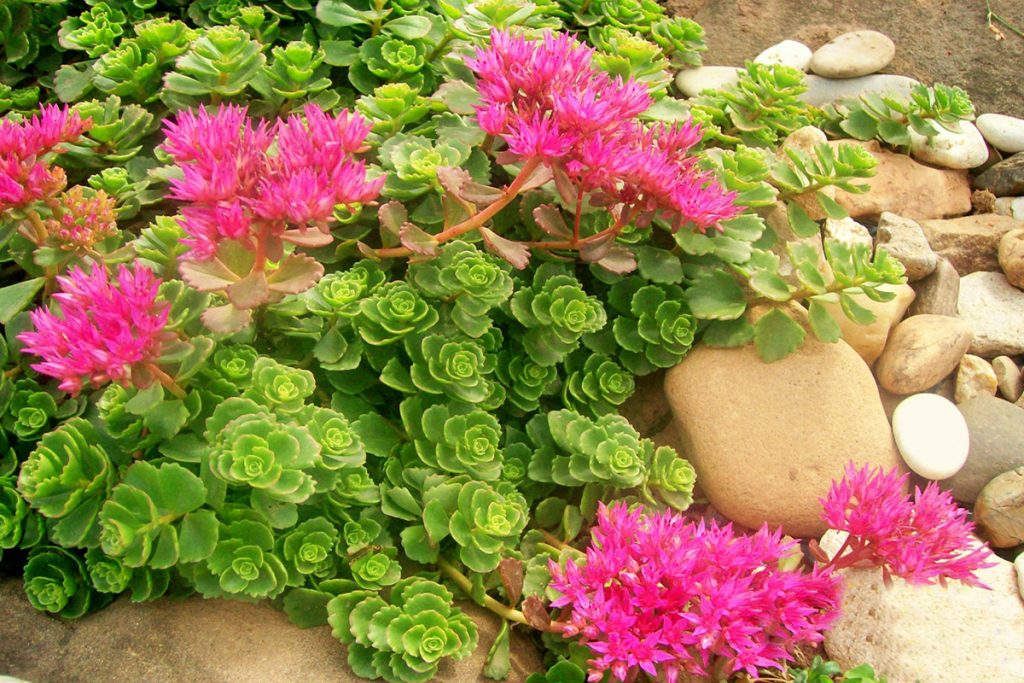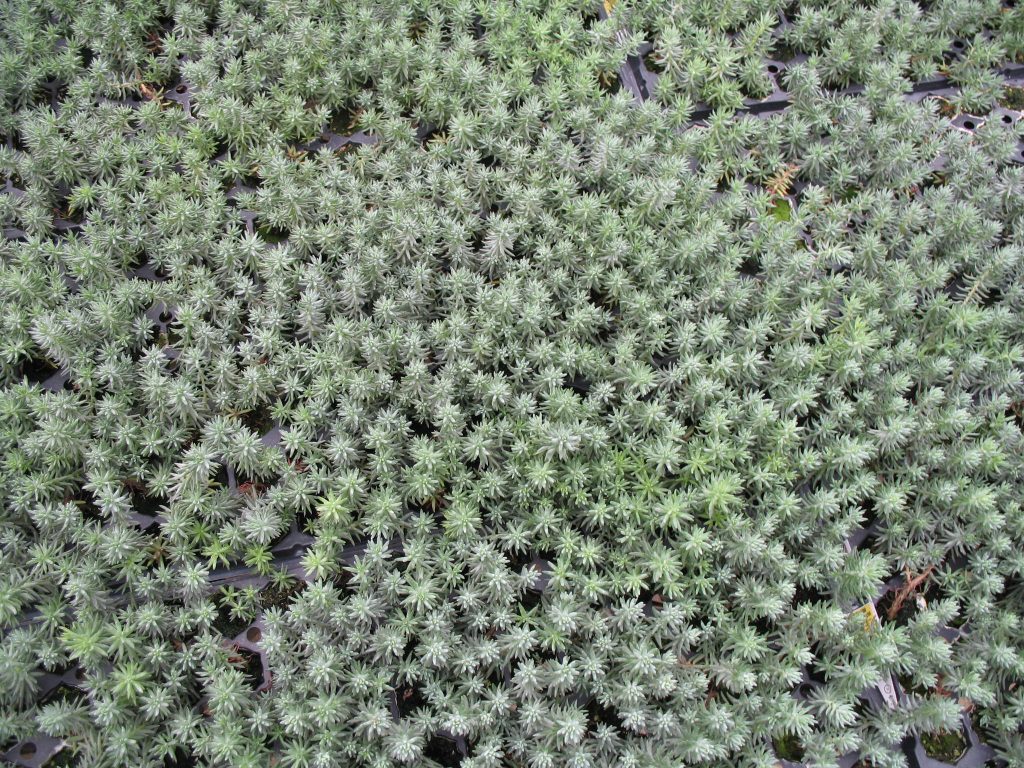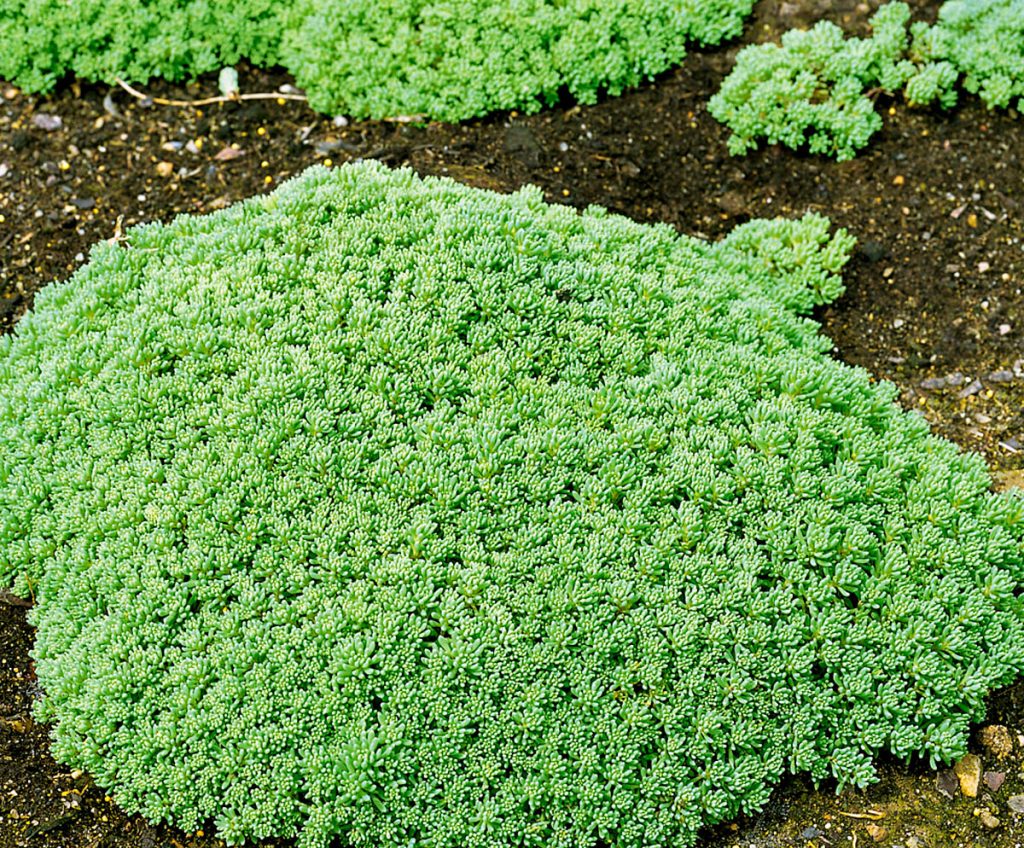Sedum ground cover
Sedum ground cover is a representative of the Tolstyankovye family. It is widely used in landscape design when creating alpine slides and organizing rocky gardens. It has a number of advantages over other horticultural crops: it is unpretentious, grows on any soil, is hardy before drought and frost.

Sedum ground cover photo
general characteristics
Ground cover plants include plants that form a dense carpet on the soil surface. Subspecies differ in shape, color and nature of development.
Sedum is a perennial succulent formed by tangled shoots. Outwardly, it resembles a stunted shrub.
The area is wide and covers Eurasia, Africa, North and South America. Grows on dry rocky slopes and fields.
Description:
- foliage is green, sometimes with a reddish tint, in some varieties it turns orange in autumn, the structure is fleshy, the arrangement on the stems is dense, alternate (whorled) or opposite;
- stems are straight, creeping, height up to 25 cm;
- inflorescences are shield-shaped, formed by small flowers, the color depends on the varietal affiliation, more often - yellow, white, pinkish, red.
Flowering occurs in the summer season, June-July. Duration from 2 weeks to a month.
Varieties
In private floriculture, several varieties are known.

Types of ground cover stonecrops
- White (Sedum album). It got its name because of its color. Differs in white star-shaped inflorescences, collected in semi-umbrellas. The height ranges from 7 to 14 cm. The stem is short, densely covered with alternate cylindrical foliage with a blunt end. Prefers rocky soils. In the wild, it grows in rocks and on walls, for which it is also called white moss.
- Caustic (Acre) A poly-stemmed plant no more than 10 cm high. The shape of the leaves is ovoid. Inflorescences are yellow, formed by five sepals. It got its name because of the toxicity of caustic vegetable juice contained in vegetative parts. The foliage is diamond-shaped, dark green. Due to the bright colors of flowers, it is popularly called a yellow rose. Grows on dry sandstones, wastelands, rocky embankments and slopes.
- Spanish (Hispanicum). Differs in a gray-red tint of vegetative mass. The shape of the leaves is fusiform. The flowers are white, star-shaped. Possesses high variability. The height of the formed carpet is about 5-10 cm. Prefers keeping in the shade.
- Kamchatka (Kamtschaticum). The color of flat toothed leaves is green with a reddish or blue tint. Medium-sized subspecies 20-30 cm high. Inflorescences are yellow or orange with red. Loves good lighting. Prefers rocky slopes.
- Siebold (Sieboldii). The bush is formed by thin recumbent stems. The foliage is green with a blue tint, the edges are reddish, there is a waxy bloom. Peduncles are pink.Low-growing subspecies up to 8 cm high.
- Rubens Lizard. Strongly branched, medium-sized species with a carpet height of about 20 cm. Shoots with pubescence and sticky bloom, covered with alternately arranged oblong leaves with a fleshy structure. Flowers are white, sometimes with a pink tinge, few in number. Prefers open clay or rubble slopes and woodlands, rock gorges.
- Evers (Ewersii). Shoots with a reddish tint, rounded shape, without pubescence. The foliage is bluish-green, opposite, rounded. Inflorescences are pinkish or crimson. The subspecies does not tolerate direct sunlight.
Purchase and adaptation period
When buying groundcover sedum varieties, first of all, you need to pay special attention to the appearance of the plant. A healthy flower culture:

Sedum ground cover types of photos
- no signs of pests and infectious diseases4
- color, shape and structure of leaves in accordance with the requirements of the variety;
- bark system without damage and rotten fragments.
The best time to buy flowers is spring. During the summer, sedum adapts to new growing conditions, builds up its vegetative mass, takes root and becomes completely ready for winter.
Sedums planted in open areas can do without adaptation. For home cultivation, the plant needs a quarantine period of about 2 weeks.
Landing features and soil requirements
The timing of planting sedum plant depends on the regional growing conditions. So, in the south, this time falls in spring (April) or autumn (September). In regions with a cold climate, the planting period is shifted so that after winter the soil has time to warm up to 10C-15C, and before the winter season there are 3-4 weeks left before the first frost arrives.

Sedum ground cover photo
A suitable place for planting a ground cover sedum is chosen depending on the variety. This can be a well-sunlit area or partial shade. A succulent planted in full shade will begin to stretch and lose its decorative effect.
All varieties fully develop even on marginal soils, which have high air and water permeability.
Technology:
- before planting, the earth is dug up and organic matter is introduced;
- make a shallow hole and water it with settled water;
- sedum is installed in the central part of the planting pit and sprinkled with soil.
The first watering after replanting is carried out after 7 days.
Growing conditions
Humidity
Humidity does not play a role for the succulent. When grown at home, the plant should not be placed near heating devices.
Temperature
Varieties with increased winter hardiness can withstand temperatures down to -29 ° C-34 ° C and are used in landscape design for decorating flower beds and flower beds. Heat-loving species are grown at home. Optimal mode:
in summer - about 25 ° С;
in winter - not lower than 10 ° С.
Lighting
The flower culture in most cases needs good light and is not susceptible to direct sun. Only some varieties require shading at peak solar activity and develop fully in partial shade.
Care rules
A succulent plant needs minimal maintenance.

Sedum ground cover varieties photo
Top dressing
Stonecrop grown in open conditions is not fertilized. The organic fertilizing introduced during the digging of the earth is enough for the flower culture before transplanting. Homemade sedum is fed up to 2 times per growing season, using fertilizers intended for succulents.
You can fertilize plants if the beginning of flowering is delayed or the leaves grow poorly. For these purposes, nitrogen-containing compounds are introduced that activate vegetative growth.
Watering
The succulent plant is drought tolerant and susceptible to overflow and stagnant water. An indoor flower is watered as the surface layer of the substrate dries, reducing and bringing the minimum in winter.Stonecrop needs watering only during the hot season.
Transfer
Young home shrubs are trying to replant annually to ensure the development of roots. For adults, plants change their place of growth every 3 years.
Pruning
An overgrown bush that has lost its attractiveness should be formed. With sanitary pruning, dried peduncles and damaged shoots are removed.
Warming
In preparation for winter, sedums grown in unfavorable climatic regions are covered with dry foliage or covering material.
Reproduction methods
The sedum is propagated by seeds, cuttings and dividing the bush.

Sedums ground cover varieties and photos
Seminal
The garden and indoor flower is propagated by seeds, but this is a laborious method that requires the creation of greenhouse conditions.
Cuttings
The easiest method to propagate sedum. The blanks are cut from the top of the shoots from a healthy plant, dried in natural conditions and planted in open ground or in a pot.
Rooting takes place in 2-3 weeks.
Dividing the bush
The most effective way to get a new bush from a parent plant that will bloom from the next season is to divide the flower into parts. Each delenka should have a pair of leaves and several root shoots. The cut off sprouts are planted in the ground or in a flower pot.
Prevention of diseases and pests
Ground cover varieties of sedum are quite resistant to attack by harmful insects and have good disease resistance. Growing problems are often associated with a violation of planting or care rules.
| Type of defeat | Control measures |
| Yellowness and shedding of leaves, the appearance of black spots. The reasons may be associated with the development of fungal diseases - gray and root rot. Appear during overflow and watering with cold water. | The roots are inspected for rotted areas that are pruned. The surviving shoots are treated with a fungicide and planted in fresh soil that has undergone preliminary disinfection. |
| Spider mite. Signs - a whitish spider web on the vegetative mass. | The plant is sprayed with an insecticidal preparation. With a small lesion, the foliage is washed with a solution of soap (50 g per 1 liter of water). |

